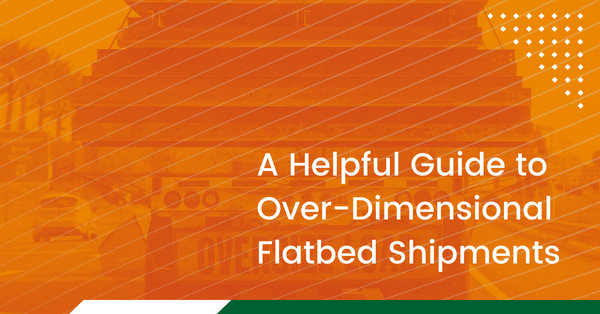Flatbed shipments that exceed the standard legal size are called over-dimensional shipments. Shippers must pay attention to their freight’s weight and dimensions, especially if it gets shipped on an over-dimensional flatbed trailer. It is also essential to know the rules and regulations for each state when transporting over-dimensional flatbed shipments.
What is a flatbed trailer?
The flatbed trailer is a piece of open deck equipment with no sides and no roof, mainly used for transporting industrial commodities. The flatbed trailer is versatile, making them a common asset for carriers. It is a basic form trailer with no sides or roof, providing quick and easy loading and unloading. These trailers often move industrial commodities (e.g., steel coils, plates, aircraft parts, and other varying steel equipment). In practice, ‘flatbed’ is often used as a general term for a few different types of open deck equipment, including:
- Step decks
- Double drop decks
- Lowboys
- Conestoga
Flatbed trailer sizes and legal flatbed dimensions
A legal flatbed trailer’s load cannot exceed 8’6” high, 8’6” wide, and 48’ long, with an average weight of around 45,000 pounds but exceeding 80,000 pounds. With traditional flatbed trailers, the driver’s view doesn’t become obstructed.
- A flatbed trailer is 48 to 53 ft in length
- Can be loaded from any direction (overhead crane, forklift side, forklift rear)
- The standard dock height is four ft. off the ground
- Loads often require tarps
Oversized flatbed dimensions
Over-dimensional flatbed trailers can handle freight up to 160’ long, 18’ high, 18’ wide, and about 200,000 pounds. Over-dimensional flatbeds have between 18 and 40 wheels. Often, over-dimensional freight obstructs a driver’s view in several ways. This scenario would need certified pilots to cover the front and rear of the trailer. They will constantly communicate with the driver to ensure the shipment goes smoothly.
Information shippers must know before obtaining over-dimensional trailer capacity:
- Exact dimensions
- Total weight
- Address of origin and destination
- Type of cargo
- Time in transit
If the dimensions are incorrect, it could cost the shipper thousands of dollars in transportation fees, especially if the shipment passes across several state lines. Listing the wrong measurements or weight could lead to improper equipment, potentially dangerous situations, or significant fines.
Rules change for over-dimensional freight as the freight gets more extensive or the carrier crosses state lines. The more specific information the shipper can offer the carrier, the better. Over-dimensional flatbed permits are typically inexpensive, but you need to ensure you have the correct ones.
Things to consider with over-dimensional flatbed shipments
Requirements for special markings
Flags and lights are placed on the tractor or trailer that you’re using. To know how many, you need to have the size of the item shipped ready to go. The flags on the tractor or trailer are red flags, and the lights are amber. Both work together to ensure everyone on the road knows there is an over-dimensional shipment. In addition to the tractors and trailers having flags and lights, the escorts need them too.
Share your schedule
The rule for most states is that over-dimensional shipments cannot travel 30 minutes before sunrise and 30 minutes after sunset during the weekdays. Also, many states don’t allow shipments to travel on holidays or weekends. Driving is busy during those times, so the loads must get protected. Before driving, it is crucial for drivers to know the rules of each state and present their schedules so they avoid dangerous situations or heavy traffic if possible.
Escort Rules
Many states require escorts for shipments that are over 12 feet wide. The safety of the cargo and other drivers on the road is the top priority. Travel escorts do a lot to help the shipment get to its destination safely. Some examples include ensuring the carrier is aware of accidents, low wires, construction zones, traffic jams, and anything else deemed dangerous. They also warn other drivers that an over-dimensional shipment is with them.
Determining over-dimensional flatbed shipments
As mentioned before, measurement and weight restrictions come with oversized shipping loads. Double-check your freight before hitting the road to ensure you meet the requirements. If your cargo is over the general measurement and weight, then it’s considered oversize and needs escorts. The flatbed drivers are responsible for getting the required permits to travel. Another essential thing to know before traveling is that if your load can get broken down to a smaller measurement or weight, it is no longer considered oversize.
Over-dimensional flatbed shipments with PLS
Request a free freight assessment to guarantee your over-dimensional load is delivered on time. We have pre-qualified, specialized carriers with the right equipment for your oversized load. In addition, we also work with 55,000 carriers and strive to have an efficient process for each one. Want help shipping your freight? Get a heavy haul quote now!

